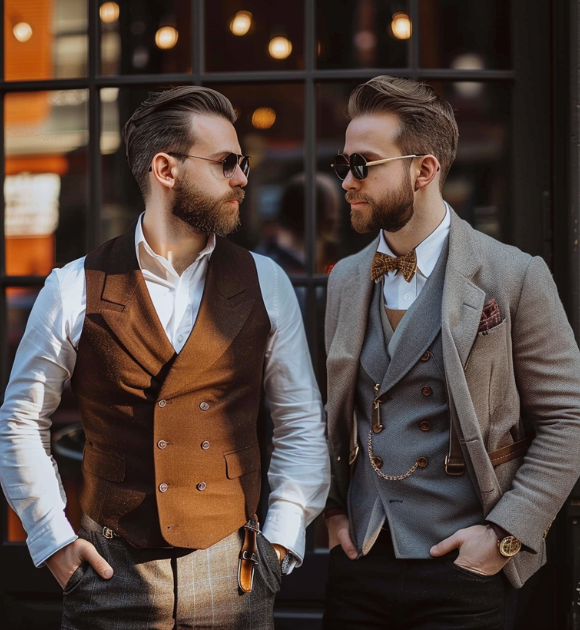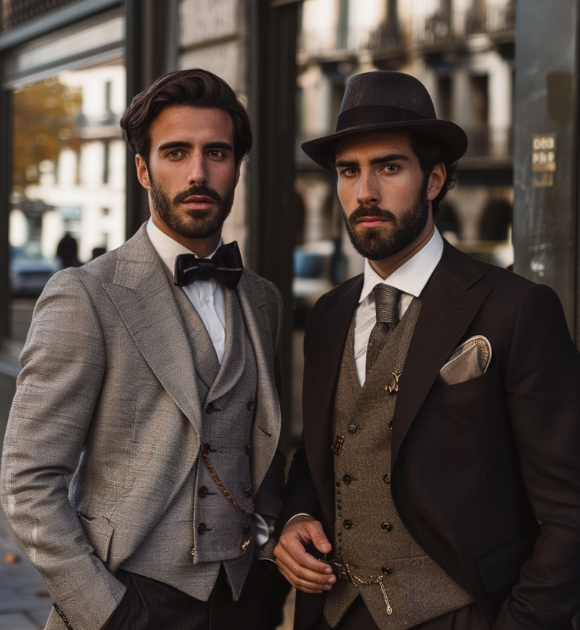Cummerbunds: Adding Elegance to Your Formalwear
Cummerbunds, also known as sashes or waistbands, are an elegant and versatile accessory that can add a touch of sophistication to any formal outfit. Traditionally worn with tuxedos, cummerbunds are a staple in men’s formalwear and can be seen at weddings, galas, and other black-tie events. In this article, we will explore the different types of cummerbunds, how to properly wear and style them, and some alternative uses for this stylish accessory.
There are various types of cummerbunds, including:
- The classic pleated cummerbund
- The slim cummerbund
- The ruched cummerbund
Each type offers a different level of formality and can be chosen based on personal preference and the occasion. A general rule of thumb is that the more pleats a cummerbund has, the more formal it is.
Proper fit is crucial when it comes to cummerbunds. They should sit at the waist, just above the hipbones, and should be snug but not too tight. The length should be long enough to cover the waistband of the pants, leaving a small gap between the cummerbund and the shirt.

To wear a cummerbund, wrap it around your waist with the pleats facing upwards. The bottom edge should align with the top edge of the waistband. The cummerbund should be fastened with the pleats facing up, creating a pocket to hold small items like tickets or cash.
When it comes to matching a cummerbund to your outfit, it is generally recommended to match it to your tie rather than your suit. This creates a cohesive and balanced look. You can also experiment with different textures and patterns for a more unique and stylish look.
Cummerbunds can be worn with a tuxedo shirt and bowtie, or with a dress shirt and necktie for a slightly less formal look. For a more casual event, a cummerbund can also be worn with a suit and dress shirt, adding a touch of luxury to your outfit.
When styling a cummerbund, it is important to keep it simple and let the accessory stand out. Avoid wearing a belt with a cummerbund, as this can create a bulky and unflattering look. Also, consider mixing and matching cummerbunds and ties for a more playful and unique look.
Aside from formal events, cummerbunds can also be used in other ways, such as a headband or a belt for a dress. Get creative and find new ways to incorporate this stylish accessory into your wardrobe. With proper fit and styling, a cummerbund can add an extra touch of elegance to your formal attire.
Key Takeaways:
- Add a touch of elegance to your formal attire with a cummerbund.
- Choose the right type and fit of cummerbund to complement your outfit.
- Get creative with styling by mixing and matching cummerbunds and ties, and consider alternative uses for this versatile accessory.
What Are Cummerbunds?
Cummerbunds are waist sashes worn with formal attire, typically paired with tuxedos or dinner jackets. Made of silk, they are worn around the waist to cover the waistband of trousers. Cummerbunds serve both a practical and aesthetic purpose, providing a polished and elegant look while also concealing the waistband. They are often paired with a bow tie for a complete formal ensemble.
Originating in India, cummerbunds were adopted by British officers stationed there. The name “cummerbund” is derived from the Persian word “kamarband,” meaning waistband or girdle. The popularity of cummerbunds spread to Western fashion in the early 20th century and they have since become a staple accessory for formal occasions.
When Should You Wear a Cummerbund?

Photo Credits @gq
A cummerbund is a stylish accessory that adds elegance to formal attire. Knowing when to wear a cummerbund can elevate your overall look. Here are some occasions to consider:
- Black-tie events: A cummerbund is traditionally worn with a tuxedo as part of a formal ensemble.
- Weddings: If you’re attending a formal wedding, a cummerbund can enhance your formalwear.
- Gala dinners: For special events like charity galas or award ceremonies, a cummerbund is a sophisticated choice.
Remember, wearing a cummerbund is optional, and personal style preferences may vary. Ultimately, it’s about feeling confident and stylish in your formal attire.
What are the Different Types of Cummerbunds?
There are a variety of cummerbunds available, each with its own unique style and design. Some common types include:
- Silk Cummerbunds: These are the most traditional and popular type, known for their luxurious and elegant appearance.
- Satin Cummerbunds: These have a smooth and shiny finish, adding a touch of sophistication to any formal outfit.
- Patterned Cummerbunds: These feature different patterns and designs, allowing individuals to express their personal style and add visual interest to their ensemble.
- Velvet Cummerbunds: These have a soft and plush texture, providing a more luxurious and opulent look.
By considering the different types of cummerbunds, you can choose one that complements your outfit and enhances your overall appearance.
How Should a Cummerbund Fit?
When wearing a cummerbund, it is crucial to ensure a proper fit that enhances your formal attire. Here are the steps to achieve the right fit for a cummerbund:
- Start by positioning the cummerbund around your waist, with the pleats facing up.
- Adjust the cummerbund to sit at your natural waistline, just above the hips.
- Fasten the cummerbund securely, making sure it fits snugly yet comfortably.
- Ensure that the cummerbund is parallel to the ground and does not bunch or sag.
- The cummerbund should completely cover the waistband of your trousers.
- Finally, check that the cummerbund is symmetrical and centered on your waist.
By following these steps, you can achieve a well-fitted and elegant look with your cummerbund.
How Do You Wear a Cummerbund?

Photo Credits @petalspromisesja
To properly wear a cummerbund and add elegance to your formalwear, follow these steps:
- Wrap the cummerbund around your waist, with the pleats facing upwards.
- Fasten the cummerbund at the back, making sure it fits snugly but not too tight.
- Position the cummerbund so that it covers the waistband of your trousers.
- Adjust the pleats so they are centered in the front and evenly spread across your waist.
- Pair the cummerbund with a matching bow tie or necktie for a coordinated look.
- Complete your formal attire by wearing a tuxedo jacket and dress shirt.
What is the Proper Placement of a Cummerbund?
The proper placement of a cummerbund is crucial for achieving a formal attire look. To ensure the desired look, position the cummerbund around the waist, just above the hips. The pleats should be facing upwards, and the cummerbund should sit parallel to the ground. It is important to have a snug fit without it being too tight. Following this placement guideline not only adds elegance to your outfit, but also creates a polished appearance. Remember to adhere to this guideline to maintain the classic and sophisticated look that comes with wearing a cummerbund.
Should You Match Your Cummerbund to Your Suit or Tie?
Deciding whether to match your cummerbund to your suit or tie is a matter of personal style and preference. While some opt for a coordinated look by matching their cummerbund to their suit, others prefer a contrasting effect by matching it to their tie. Ultimately, there are no strict rules when it comes to choosing a cummerbund. The most important thing is to select one that complements your overall outfit and enhances your personal style. Whether you choose to match or mix, the key is to feel confident and comfortable in your decision.
Fun fact: Originating in India, the cummerbund was originally worn as a functional garment to protect against the heat and dust.
What Should You Wear with a Cummerbund?
When wearing a cummerbund, it’s important to pair it with the appropriate attire to create a polished and elegant look. Here are some suggestions for what to wear with a cummerbund:
- Tuxedo: A cummerbund is traditionally worn with a tuxedo. It adds a sophisticated touch and helps create a streamlined appearance.
- Bowtie: Pair your cummerbund with a matching or complementary bowtie. This combination is classic and timeless.
- Dress shirt: Wear a crisp, white dress shirt with your cummerbund. This creates a clean and polished look that is perfect for formal occasions.
- Suit: In some cases, a cummerbund can be worn with a suit instead of a tuxedo. However, this is less common and may depend on the formality of the event.
Remember, when wearing a cummerbund, it’s important to consider the overall look and ensure that all elements of your outfit are well-coordinated.
What are Some Tips for Styling a Cummerbund?
Styling a cummerbund can take your formal attire to the next level of sophistication. Here are some tips to help you achieve a polished look:
- Fit: Make sure the cummerbund fits snugly around your waist, covering the waistband of your trousers.
- Placement: Position the cummerbund with the pleats facing upward and ensure it sits at your natural waistline.
- Coordination: Match the cummerbund color to your bow tie or other accessories for a cohesive look.
- Contrast: Consider pairing a cummerbund in a contrasting color or pattern with your suit for a stylish touch.
- Experiment: Don’t be afraid to experiment with different cummerbund styles, fabrics, and textures to add your own personal flair to your outfit.
Fun Fact: The cummerbund originated in ancient Persia and was traditionally worn by men as a sash around the waist to hold items such as daggers and money.
Can You Mix and Match Cummerbunds and Ties?

Mixing and matching cummerbunds and ties can be a stylish way to express your personality with formal attire. While some may prefer a coordinated look, others enjoy the freedom to experiment with different patterns and colors.
When mixing cummerbunds and ties, consider the color palette and overall aesthetic. Opt for complementary or contrasting colors, and make sure the patterns complement each other. Ultimately, the choice is yours, and it’s a chance to showcase your personal style and creativity. Just remember to maintain balance and harmony in your ensemble.
Here’s a true story: A friend once paired a burgundy cummerbund with a paisley tie, creating a unique and eye-catching combination that received many compliments at a formal event.
Should You Wear a Belt with a Cummerbund?
Is it necessary or recommended to wear a belt with a cummerbund?
The purpose of a cummerbund is to provide a polished and streamlined look to formalwear, especially with tuxedos. The cummerbund should be worn at the waist, covering the waistband of the trousers. Adding a belt can create an unnecessary and bulky layer that disrupts the sleek appearance. Instead, focus on ensuring the cummerbund fits properly and complements the rest of your attire. Pair it with a matching bow tie or necktie, and consider coordinating the cummerbund color with other accessories for a cohesive look.
What are Some Alternative Uses for a Cummerbund?
What are Some Alternative Uses for a Cummerbund?
A cummerbund, typically worn with formal wear, can also serve alternative purposes beyond its intended use:
- Concealing items: The wide waistband of a cummerbund can discreetly hide small objects such as a folded handkerchief or a spare key.
- Waist cinching: When worn over a loose-fitting dress or blouse, a cummerbund can cinch the waist, adding definition to the silhouette.
- Fashion accessory: A cummerbund can be repurposed as a stylish belt, adding a touch of elegance to any outfit.
- Table runner: In a pinch, a cummerbund can be used as a decorative table runner for a formal dinner or event.
- Gift wrapping accent: The pleated design of a cummerbund can be a unique and decorative addition to gift wrapping, adding a touch of sophistication.
These alternative uses showcase the versatility of the cummerbund and its ability to add a touch of elegance to various aspects of life.
Frequently Asked Questions
1. What is a cummerbund and why is it a popular choice for formal events?
A cummerbund is a fabric wrap worn over a formal shirt and trousers, creating a solid line of color between the chest and midsection. It is a popular choice for formal events due to its elegant and refined look, as well as its cultural and military associations.
2. How did the cummerbund become associated with black tie attire?
The cummerbund was first popularized in the 1850s by British military officers stationed in India. It was later adopted by the aristocracy as an accessory for their tuxedos, and has since become a staple in the fashion world for formal events.
3. What is the difference between a cummerbund and a vest for a three piece suit?
Both the cummerbund and vest serve the purpose of covering the waist in a formal outfit. However, the cummerbund is a fabric wrap while the vest is a separate garment. The choice between the two depends on personal preference and body style.
4. How do I choose the right cummerbund for my outfit?
When choosing a cummerbund, it is recommended to match it with the trouser stripe or lapels of your tuxedo. Dark hues are often favored, but the material should be soft and comfortable, such as satin or velvet. However, personal style and preference should also be taken into consideration.
5. Can wedding couples also benefit from wearing a cummerbund?
Yes, wedding couples can receive a free rental for a suit or tuxedo with 5 paid members, or keep the suit or tuxedo for free with 7 paid members. Many grooms also opt for matching cummerbunds for their wedding parties, adding a touch of elegance to their outfits.
6. What are the color options for a cummerbund in formal black tie attire?
The color options for a cummerbund are limited to midnight blue or black. However, black is the most versatile choice and is often considered the standard for formal events. The color of the cummerbund should also match the color of the bowtie for a cohesive look.
